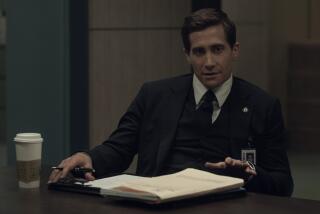‘Prime Suspect II’ Makes a Strong Case : London Inspector Jane Tennison Is Back in the Best Drama of the Season
- Share via
The best miniseries of the season--make that best drama--arrives this week on PBS.
The rave may be premature, given that the 1992-93 season still has a way to go. Yet it’s hard imagining anything on television in the coming few months that would match the stunningly good “Prime Suspect II,” to say nothing of Helen Mirren’s flawless acting as a driven, unglamorous London police detective in this British-made sequel to last season’s “Prime Suspect.”
“Prime Suspect II” surfaces as part of public TV’s “Mystery!” series. The first of its four episodes airs Thursday at 9 p.m. on KCET-TV Channel 28 and at 8 p.m. on KPBS-TV Channel 15, and on Sunday at 8 p.m. on KOCE-TV Channel 50 and at 10 p.m. on KVCR-TV Channel 24.
When it comes to female cops (an undernourished TV genre), nothing on U.S. airwaves has even approached this brand of film noir from Granada Television. Not “Cagney & Lacey.” Absolutely not “Police Woman”--Mirren’s Detective Chief Inspector Jane Tennison is surely not Angie Dickinson’s Sgt. Pepper Anderson. Nor, except for her tenacity, does the protagonist of “Prime Suspect II” resemble Amanda Donahoe’s recent stiff-arming, cop-turned-bounty-hunting adventurer in NBC’s “It’s Nothing Personal.”
It was last season’s memorable “Prime Suspect” that traced the anti-sexist struggle of the high-achieving, laser-focused, obsessively ambitious Tennison as she virtually bullied her boss into letting her head a high-profile serial murder investigation despite resistance from most of her male colleagues. When her boss is up for promotion in “Prime Suspect II,” Tennison lobbies hard to replace him as head of the division, determined not to be passed over because she’s a woman.
Although anti-female bias smolders throughout the sequel, its mingling with equally combustible racism--touching off an explosive double whammy--is what makes “Prime Suspect II” even more interestingly complex and political than its predecessor. And a subplot concerning Tennison’s brief fling with black Detective Sgt. Bob Oswalde, himself a target of prejudice on the force, injects another element of volatility. Their destructive tryst turns out to be a shocking lapse in judgment by Tennison, one that comes back to bite her.
Director John Strickland makes no false moves here. And taking over for “Prime Suspect” writer Lynda La Plante, Allan Cubitt has crafted a “Prime Suspect II” script richer by far than that of his recently aired “The Countess Alice.”
His trigger here is the discovery of the decomposed body of a young woman in an Afro-Caribbean district of London that’s a tinder box of rising tensions between police and the West Indian citizenry. A distraught mother, whose son may have been wrongfully convicted of a murder in a previous police-botched case, claims the body is that of her missing daughter. Facing mounting political pressure to resolve the case quickly, Tennison and her unit go to work. Later, police brutality intervenes, resulting in a tragic mistake that costs a life.
“Prime Suspect II” is part old-fashioned mystery, a hairpin-curvy, twisty process that keeps you in doubt not only about the perpetrator but also the victim. The eeriest sequence in the entire series centers on a clay model of the nameless victim’s head that has been reconstructed from her decayed skull. Its slow unveiling by a police sculptor takes on the suspense of the unveiling of a Rodin. Tennison ponders the model thoughtfully, as if to read human emotion into its lifeless gray eyes.
More nitty-gritty are her interactions with male cops, especially Oswalde, played with raw, searing energy by Colin Salmon. He becomes her worst nightmare in this death-tinged case, which, as the emotionally spent Tennison somberly observes, is a virtual “graveyard” of corpses.
Watching Mirren’s subtle expressiveness as this flawed, tough, nerve-jangled woman who plays a men’s game to gain men’s respect is infinitely rewarding. It’s a great role, and she lives up to it. It’s a soothing tenderness that we see from her when Tennison--a detective skillfully manipulating a dying suspect--feigns compassion to try wheedling a deathbed confession from a criminal she loathes. Gently stroking him and speaking in a whispery voice, as if noise alone could kill him before he blabbed, this is Mirren at the top of her craft.
Last season’s “Prime Suspect” ended with Tennison visibly sagging in court when a serial killer whom she triumphantly had made confess reversed himself and pleaded not guilty. A metaphor for Tennison’s continuing struggle, it was a frozen moment, an enormous loose end left swinging like a noose. “Prime Suspect II” also departs on a note of frustration, its heroine once more denied, still a work in progress--literally, it seems, for on the board for Mirren next season, happily, is “Prime Suspect III.” Plus, Universal Studios is considering a “Prime Suspect” feature film, presumably set in the United States and Americanized.
Fat chance of it being as prime as the TV versions. Without Mirren, it couldn’t be.
More to Read
The complete guide to home viewing
Get Screen Gab for everything about the TV shows and streaming movies everyone’s talking about.
You may occasionally receive promotional content from the Los Angeles Times.






